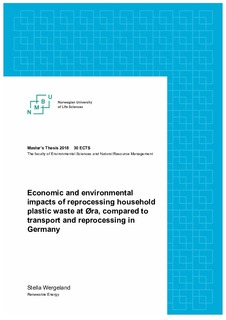| dc.contributor.advisor | Hanssen, Ole Jørgen | |
| dc.contributor.advisor | Askham, Cecilia | |
| dc.contributor.author | Wergeland, Stella | |
| dc.date.accessioned | 2018-10-01T08:33:45Z | |
| dc.date.available | 2018-10-01T08:33:45Z | |
| dc.date.issued | 2018 | |
| dc.identifier.uri | http://hdl.handle.net/11250/2565389 | |
| dc.description.abstract | Since the early 19-hundreds, plastics have been a valuable product for humans. Production has expanded throughout decades, leading to increased volumes of plastic waste. Insufficient treatment of plastic waste leads to numerous disadvantages for environment and humans. To minimize the negative effects, and sustain the value of the resource, plastic recycling is necessary. Reprocessing of plastic waste, including washing and extrusion, is a central part of this. As Norwegian household plastic waste is currently exported to Germany for this retreatment, research of running a plastic reprocessing plant in Norway was of interest.
This study included two analyses investigating if a plastic reprocessing plant should be established at Øra in Fredrikstad, or if Norway should continue exporting household plastic waste to Germany. Data from two machine suppliers were compared in terms of costs and resource consumptions. First, a Net Present Value (NPV) analysis was conducted, including installation and 20-years operation of a facility at Øra. Secondly, an environmental analysis calculated and compared green house gas (GHG) emissions of two scenarios: (1) Operation of a plastic reprocessing plant at Øra, and (2) transport of plastic waste from Øra to Germany, including similar retreatment process in Germany. By using Life Cycle Assessment methodology, total green house gas emissions over the projects life time was presented, with use of different electricity mixes in both countries.
Both the economic and environmental analyses showed net benefits of reprocessing household plastic waste at Øra. Best option resulted in a NPV of NOK 41,821,700, and net saving of CO2-equivalents during the life time between 15,304 - 72,914 tonnes. The NPV was most sensitive to change in plastic input amounts and variable costs, and the environmental analyses presented electricity mix as most decisive factor. | nb_NO |
| dc.description.abstract | Siden tidlig på 19-hundretallet har plast vært en verdifull ressurs for mennesker. Produksjonen har ekspandert over generasjoner, som har ledet til økte mengder plastavfall. Utilstrekkelig behandling av plastavfallet leder til flere ulemper for miljøet og befolkningen. For å minimere de negative effektene, samt bevare verdien til ressursen, er plastresirkulering nødvendig. Etterbehandling av plastavfall, inkludert vask og ekstrudering, er en sentral del av denne prosessen. Ettersom norsk husholdningsplast i dag blir eksportert til Tyskland for etterbehandling, har undersøkelse om drift av et etterbehandlingsinlegg i Norge vært av interesse.
Denne studien inkluderte to analyser som undersøkte om et etterbehandlingsanlegg for plast burde bli etablert på Øra i Fredrikstad, eller om Norge burde fortsette å eksportere husholdningsplasten til Tyskland. Data fra to maskinleverandører ble sammenlignet, basert på kostnader og ressursforbruk. Først ble en nåverdianalyse gjennomført, som inkluderte installering og 20-års drift av et anlegg på Øra. Deretter ble en miljøanalyse utført, som beregnet og sammenlignet drivhusgass-utslipp fra to scenarier: (1) Drift av et etterbehandlingsanlegg for plast på Øra, og (2) transport av plastavfall fra Øra til Tyskland, inkludert tilsvarende etterbehandling i Tyskland. Ved bruk av livsløpsanalyse som metodeverktøy, ble totalt utslipp av drivhusgasser over anleggets levetid presentert, ved bruk av ulike elektrisitetsmikser i begge land.
Både den økonomiske analysen og miljøanalysene viste fordeler ved å etterbehandle plastavfallet på Øra, fremfor transport og behandling i Tyskland. Beste alternativ viste en nåverdi på NOK 41,821,700, og en netto besparelse av CO2-ekvivalenter over anleggets livsløp mellom 15,304 – 72,914 tonn. Nåverdien var mest sensitiv for endringer i mengder plast behandlet, samt variable kostnader, mens miljøanalysen viste valg av elektrisitetsmiks som mest utslagsgivende faktor. | nb_NO |
| dc.language.iso | eng | nb_NO |
| dc.publisher | Norwegian University of Life Sciences, Ås | nb_NO |
| dc.rights | Attribution-NonCommercial-NoDerivatives 4.0 Internasjonal | * |
| dc.rights.uri | http://creativecommons.org/licenses/by-nc-nd/4.0/deed.no | * |
| dc.subject | Plastic | nb_NO |
| dc.subject | Circular economy | nb_NO |
| dc.subject | Recycling | nb_NO |
| dc.title | Economic and environmental impacts of reprocessing household plastic waste at Øra, compared to transport and reprocessing in Germany | nb_NO |
| dc.type | Master thesis | nb_NO |
| dc.description.version | submittedVersion | nb_NO |
| dc.description.localcode | M-FORNY | nb_NO |

